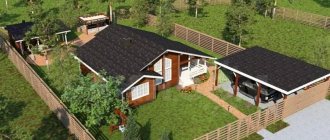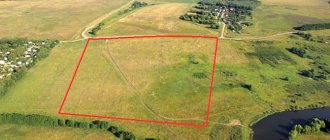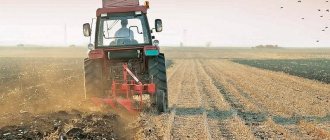According to the legislation of the Russian Federation, lands of populated areas (LNP) include areas located in the populated area itself or in the territory adjacent to it. The main task of these lands is the development of the city or settlement to which they belong. Residential buildings and public facilities are being built on such lands.
However, building a residential building or farming a subsidiary plot is not permitted on all plots. The reason for this is that all lands of settlements are distributed according to destination groups. So, if the site is intended for cattle breeding or gardening, then a commercial facility built on it will be considered illegal. For the owner of the building, this status means demolition, as well as a fine of 1% of the value of the site. In this case, the amount of the fine cannot be less than 10 thousand rubles.
To avoid such situations, it is necessary, even before construction, to find out everything about the purpose and type of permitted use of the site. This is easy to do, just know the cadastral number of the land and find the plot on the Rosreestr website (rosreestr.ru). Or send a corresponding request to local authorities. We will tell you how to do this correctly in this article.
VRI: Types of permitted use
Let's start with the main thing - the purposes of using the plots. VRI for each type of plot is prescribed in Article 83 of the Land Code of the Russian Federation. Information regarding the permitted use of the territory of interest can be obtained on the Rosreestr website.
Let's take a closer look at what VRIs exist and what restrictions are imposed on landowners.
Residential
All areas with a cadastral code from 2 to 2.7 fall under the “Residential” classification. These figures imply the following types of buildings:
- construction (for individual residential construction). This item includes the construction of private residential buildings with a height of no more than three floors;
- Country construction . It is allowed to build houses of no more than 3 floors;
- Private household plot On such lands it is allowed to build a house, also no higher than 3 floors. At the same time, the following types of activities are permitted in the adjacent territory: planting seedlings, gardening, breeding and raising livestock;
- Townhouses . In such areas, the construction of semi-detached houses with common walls is permitted. The total number of blocks (entrances) should not exceed 10, height - a maximum of 3 floors. It is allowed to plant flower beds, plant trees, and build utility structures on the plots;
- Mobile housing . For example, campsites or tent cities;
- Mid-rise development . The construction of multi-storey, apartment buildings is permitted in these areas. The total height of mid-rise residential complexes, excluding basements, should be no more than 8 floors;
- Multi-storey development . Residential apartment buildings with a height of nine floors.
- Construction of service buildings . It is allowed to build utility rooms for housing and communal services.
What land can be used for summer cottage construction?
| Land category | Type of permitted land use | Description, development possibilities. |
| Lands of settlements | Summer cottage farming Gardening | The plots can be used for construction by owners and members of non-profit associations. Plus: no building permit required. Minus: You cannot build a permanent garage. |
| individual housing construction | Used for construction only by owners. Plus: You can build a permanent garage. Cons: Building permit required. | |
| Private household plots | Used for construction by owners and tenants from the municipality. Pros: you can have a large garage, you can keep farm animals. Minus: you need a building permit. | |
| Agricultural land | Gardening | You cannot build a permanent house before transferring it to city land. Pro: Easy to convert to urban lands, usually larger maximum area allowed than urban gardening lots. |
| Private household plots | You cannot build permanent houses. Cannot be transferred to city lands. Plus: Can be transferred to plots for peasant farms with a large permitted area (up to 5 hectares) and the possibility of building a house. |
It is important to remember that from January 1, 2021, all dacha plots are equivalent to garden plots, according to Federal Law No. 217 of July 2021.
Garden plots located on agricultural lands near the borders of settlements can be transferred to the category of urban lands in order to be able to build on such plots.
The translation process occurs in the following order:
- The owner submits a request for transfer to the regional land committee;
- The application is considered within 60 days;
- A decision is made to transfer or refuse;
- If the decision is positive, an act on changing the category of land is adopted.
A refusal may be obtained if local authorities prohibit changing the category of land in a given territory, as well as if the land is of particular value, or its cadastral value is more than 1.5 times higher than the average for the subject of the federation.
There is no need to change documents for a land plot after changing the category, according to clause 4 of Art. 5 Federal Law No. 172 “On the transfer of lands...”.
How to calculate salary based on salary? We'll tell you! What are the features of calculating sick leave during your pregnancy? You can learn about them and understand their intricacies here.
You will find out what the maximum period of time you can count on when receiving sick leave is if you follow the link and read our material.
Subtypes (subtypes) of VRI
Permitted uses are further divided into three types:
- Basic;
- Conditionally permitted;
- Auxiliary.
Let's look at them in more detail.
The main VRI determines the best use of the site and the choice of building on it. This means that if the site is located in a residential area of a populated area, it is most correct to issue a building permit:
- Residential building;
- Store;
- Publicly useful institution.
That is, the building must correspond as closely as possible to the zone in which it is located and not cause inconvenience to the residents of the locality.
Auxiliary VRI means that the buildings on the site are secondary in nature and must comply with the main VRI. In simple terms, the main VRI is the house, and the garage and outbuildings are the auxiliary type.
A conditionally permitted VRI of a site is formalized through the court. This happens as follows:
- The owner of the plot submits an application to the administration stating that, in his opinion, the land is not being used effectively;
- This application is sent to the court, which can either reject the request or add a new VRI. At the hearing on this case, both the initiator of the application and the neighbors of the site must be present.
On what plot can you build a house?
Dacha construction and outbuildings are allowed on a garden plot, regardless of what the purpose of the plot will be in the future.
According to the new law on gardening (Federal Law No. 217, Article 3, link to the law - https://www.consultant.ru/document/cons_doc_LAW_221173/), in force from 01.01.2021, a garden plot is a land plot aimed at growing citizens of agricultural crops for personal purposes with the right to erect garden houses, residential buildings, garages and outbuildings.
The concept of “dacha” is no longer used in the law. All partnerships are divided into garden land plots and vegetable plots:
- In garden plots, only the cultivation of crops and the construction of outbuildings are allowed, but the construction of permanent buildings is prohibited.
- It is allowed to build a house on garden plots and register in it in accordance with the established procedure. It became mandatory to obtain a permit to build a residential building.
It is allowed to build a cottage on a plot allocated for farming activities, since the farmer’s family must live in comfortable conditions. In addition, the farm involves the presence of animals that require round-the-clock care, so building a house for the farmer's family is taken for granted. The main condition is that the farm must be officially registered with local authorities.
Many people who intend to build a house on agricultural land are put off by purchasing plots allocated, for example, for summer cottage construction.
Read more about what can be built on the lands of private household plots here.
However, in Art. 1 of the Federal Law “On the turnover of agricultural land” emphasizes that this law does not apply to plots provided from agricultural land to citizens for:
- construction of individual houses and garages;
- maintaining private household plots;
- dacha farming;
- carrying out gardening;
- livestock farming;
- gardening.
This law (https://www.consultant.ru/document/cons_doc_LAW_37816/) also does not apply to areas occupied by buildings, buildings, and structures. All listed areas are subject to the Land Code of the Russian Federation.
Responsibility for misuse of land
The state provides for administrative liability for inappropriate use of land. Despite high fines, many landowners break the law. Why is this happening?
Quite often, people, wanting to save on taxes, begin to use land for other purposes. For example, a store or workshop is being built on a site for individual housing construction.
Indeed, it is much more profitable to use an existing plot for business than to buy a new one. In addition, taxes on commercial plots (for doing business) are much higher than usual.
As practice shows, enterprises and firms that operate on sites with other purposes that are not suitable for this purpose do not live long. One complaint to Rosreestr is enough, and its sender can be anyone. Most often this is:
- Neighbour;
- Prosecutor's office.
- Russian Federal Migration Service.
After receiving such a complaint, an inspector comes to the site. If the fact of misuse of land is confirmed, then a letter is sent to the owner indicating the violations that must be eliminated.
Is it possible to build a house on agricultural land in 2022?
The possibility of constructing and using buildings on such sites is determined by the type of economic activity on such site. Agricultural land is suitable for gardening, dacha and homestead activities.
The list of permitted activities in a certain area is included in the cadastral passport of this area. It can be:
- homestead farming;
- Individual housing construction (individual housing construction);
- gardening and gardening;
- arable land;
- livestock farming and grazing;
- agricultural production.
Each direction for successful activity requires special buildings for different purposes. For example, summer residents need a country house, farmers need a hangar to store harvested grain or tools.
Construction on agricultural land is permitted for:
- houses for individual use and economic activity;
- cottages;
- country house or garden house;
- outbuildings;
- hangars, cellars, warehouses for the production and storage of own products;
- farm (farm);
- equipped reservoirs for fish breeding.
From the above list, the construction of a residential building on a plot of land classified as individual housing construction and gardening are permitted.
If the land plot does not belong to this category, but there is a need to build a house on agricultural land, then you will need to change the category of the plot, that is, transfer it to the category of gardening and individual housing construction. To do this, you should contact your local administration.
Before purchasing a plot of land on agricultural land, it is recommended to find out in advance whether it is allowed to build a house here or whether it is possible to transfer this plot to another category for the purpose of building a house.
Peculiarities of maintaining private household plots on the lands of populated areas
The construction of facilities for personal subsidiary plots on the territory of populated areas differs from construction on agricultural land. In both cases, on the territory of private household plots you can engage in one of three types of activities:
- gardening;
- horticulture;
- livestock breeding.
The difference is that private household plots can be built freely in populated areas. But to build private household plots on farmland, you will need permission from a special commission. The main criterion for the construction of buildings and structures in the second case is the permanent intended use of the land.
How to connect an on-farm road on agricultural land to a local road?
Agricultural lands are located outside populated areas. They include on-farm roads used to ensure the normal operation of agricultural enterprises. They carry out the delivery of agricultural products to places of storage and processing, as well as other movement necessary to maintain the operation of a peasant farm or other farm.
To ensure that land owners and users can easily reach their own plots, local roads are used. But most often, a broken dirt road leads from them to on-farm roads. In some cases, it is a track rolled by tractors (it is used to move equipment for cultivating fields).
Considering that agricultural lands are located outside populated areas, you must contact the district administration to connect on-farm roads to local roads. In addition to the application you will need:
- title documents for the site;
- plan of the territory and placement of the connecting road;
- traffic organization diagram (how the congress will be carried out);
- cartographic materials and other papers.
The list of documents may vary depending on the situation. The application contains information about the coordinates of the land, the type of rights the applicant has, the current condition of the road and a request for accession.
It will take about 30 days to review your application. The answer depends on many factors, but most often take into account financial costs. If to connect two roads it is enough to organize an exit and put up signs, the administration will agree to carry out the work. If you have to build an access road from a local road, the likelihood of failure will increase.
In order for the joining to take place, you need to correctly compose an application and collect a complete list of documents. Even if the service is refused, such a decision can be appealed in court. The land lawyers of the Geobureau will help you with this. Specialists will prepare the necessary papers, draw up an application and achieve the connection of the on-farm road.
What is required to build the facility?
To begin construction work, it is necessary to draw up a number of documents to permit the use of the land plot for summer cottage construction. First you need to prepare a package of papers:
- application requesting permission to erect a building;
- cadastral plan of the land plot;
- passport or alternative document to confirm identity;
- confirmation of ownership of the site;
- diagram of the future building.
Before starting construction, you need to collect many documents, including a plan of the building itself
Features of selling a land share
If there are more than 5 participants in shared ownership of a land plot of agricultural land, the restrictions established by law are applied to the transaction: a participant in shared ownership has the right, at his discretion, to sell the land share only to another participant in shared ownership, as well as to an agricultural organization or a citizen member of a peasant (farm) farm using this land plot. At the same time, it is not required to notify other participants in shared ownership of the intention to sell their land share.
If there are 5 or fewer participants in common shared ownership, the general rules for the sale of a share in the right of common shared ownership apply to the transaction for the sale of a land share. Such a transaction can be completed no earlier than a month from the date the seller of the land share notifies the remaining participants in shared ownership about its sale, or earlier than this period if all other share owners renounce the pre-emptive right to purchase in writing. Read more about shared ownership transactions.











